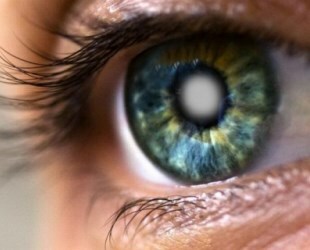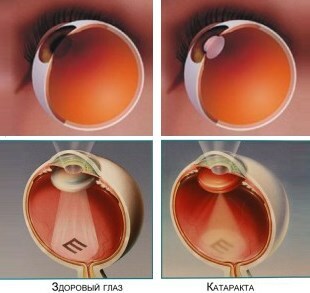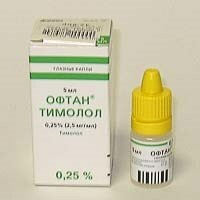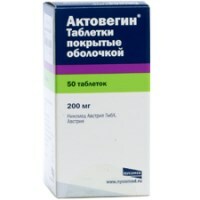
Cataract is a common eye disease among the elderly, but can affect the eyes of people of any age.
The lens, located in the eye of a person, performs the function of a "natural lens", which, by breaking, transmits a light beam.
In a healthy state, the ophthalmic lens is transparent, elastic, easy to "focus" and, as a result, a person can see at any distance.
When cataracts the lens partially or fully, loses its transparency, the eye "catches" light rays in part. Naturally, the vision begins to decline and the "picture" is seen blurry. If you do not take action immediately, then this disease will lead to blindness.
- 1. Description of
- 2. Symptoms of
- 3. Causes of
- 4. Diagnosis of
- 5. Surgery
- 6. Prevention of the disease
- 7. Myths about cataract
- 8. Results of
Description of the disease
Species
Cataract can be:
- congenital;
- traumatic;
- complicated;
- beam;
- caused by common diseases;
- age( senile);
Stages of
The degree of development of zabrlevaniya can be different. Here are the main ones:
- Initial: when the changes are insignificant and do not cause trouble.
- Immature: when there is a marked decrease in vision accuracy.
- Mature: which reduces vision to a simple sense of light.
- Perezrelaya : full blindness comes, it is visible on the white pupil.
According to WHO, cataracts affected 17,000,000 people who only crossed the sixty-year mark. Also, according to statistics, 20,000,000 people worldwide who have a history of this disease have been blinded!
Symptoms of

To ancient Greeks this disease is known as kataraktes, which means "waterfall".With this disease, vision becomes hazy, a person sees objects through a "waterfall" or "misted glass".
If the function of vision worsens, flashing in front of the eyes of frequent spots more and more, a halo is seen around each object, there is photophobia and double vision in the eyes.
It's hard to read, write, work with small objects, sew. As the disease develops, the color of the dark pupil turns white.
Causes of the disease
In fact, scientists still can not say exactly what is causing cataracts. But they agree that the following factors approximate the onset of this disease:
- genetic location;
- eye injury( chemical, mechanical);
- trauma of the eye as a result of concussion;
- various eye diseases( eg, glaucoma or nearsightedness);
- endocrine disorder( impaired metabolism, diabetes, beriberi);
- irradiation;
- continuous reception of medicines;
- radiation;
- being in an unfavorable ecological situation;
- toxic poisoning;
- the constant use of nicotine;
Diagnosis
Diagnosis of cataracts is complicated by the fact that with a significant opacification of the lens it becomes difficult to thoroughly examine the viscera and the retina. But modern methods of diagnostics make it possible to overcome this complexity. These include:
- Definition of visual acuity( visometry).The procedure is necessary to establish whether cataracts are harmful to visual function.
- Perimetriya - study of fields of vision. It is assigned with the same purpose as the visometry.
- Tonometry - determination of intraocular pressure.
- Biomicroscopy is one of the most important diagnostic procedures. It allows you to carefully examine all the tissues of the eye, including the lens. The examination is carried out using a slit lamp after preliminary instillation in the eyes of drugs that dilate the pupil.
- Gonioscopy is the study of the angles of the eye chamber. The procedure is necessary for the comprehensive diagnosis of glaucoma and cataract.
- Ophthalmometry is a procedure that measures the curvature of the lens.
- Ophthalmoscopy allows you to examine the retina and establish the fact of its detachment, which can accompany cataracts.
Surgery
In modern medicine, the following surgical methods are used:
1) Extracapsular extraction( ECEC) is one of the oldest surgical ways to remove cataracts, it has been known since the 1960s. It is characterized by relative rudeness and high invasiveness, but it is simple and inexpensive.
In ECEK, the eye is cut and the lens is removed from it almost entirely( only the posterior capsule remains), instead of it an artificial lens is implanted. Restoration of the integrity of the shell requires suturing, which affects the visual acuity: astigmatism and myopia develop. Despite the difficult recovery period, the operation has one significant advantage - it can be carried out at mature stages of cataract and with a relatively coarse crystalline lens.
The average price of the operation is 22 thousand rubles.
2) Intracapsular extraction( IEK) is an even more radical operational method. From ECEC, it differs in that it assumes complete removal of the lens with all residual tissues. This is useful in cases where there is a risk of growth of the tissues of the affected lens with subsequent distortion of vision. In comparison with the ECEC, the operation has even more side effects, for example, infection and detachment of the vitreous are possible.
The average price is 30 thousand rubles.
Both types of surgery are performed only under general anesthesia.
Both in ECEC and in ECI it is important to choose the correct lens for implantation. The lens can be replaced not only by a similar lens, but also by one that will correct these or other visual defects by adjusting the refractive force to individual human parameters. The patient can be implanted:
- Monofocal lenses. They give the same refraction by a certain amount over the entire surface, suitable for people with nearsightedness and farsightedness. The principles of lens selection are in many respects similar to the criteria for choosing glasses.
- Toric lenses. They have different refractive power in each meridian. Suitable for correction of astigmatism.
- Encoding lenses. Implant to people without visual impairment.
Good multifunctional lenses cost a lot of money, their price can exceed the cost of performing the operation.
3) Ultrasonic phacoemulsification is a more advanced and safe method of cataract removal.
On the skin of the eye microregun is made with a diamond knife, a microscopic needle is introduced into it, which starts to crush the lens, moving with a very high frequency under the influence of ultrasound. Simultaneously with the help of another needle( it is hollow inside), its fragmented fragments are removed. Then an artificial lens is implanted into the formed free space. Trauma surgery is minimal, the number of possible complications is relatively small.
The average price is 40000 rubles.
4) Laser phacoemulsification is the newest existing surgical technique. The laser surpasses the mechanical needle by its crushing force, which makes it suitable for removing even the coarsest and hardened lenses. The procedure for performing the operation is generally identical to the algorithm for applying the ultrasound method.
The average price is 80000 rubles.
To postpone treatment of such a serious disease as cataract is not recommended!
- You need to take one liter of running water. Put in the container with this water silverware or silverware for 7 days. Then, after the specified time, you need to brew in this infused water finely chopped aloe leaves. Add 15 grams of natural honey to the mixture. The resulting liquid should be thoroughly stirred and filtered. Bury in the eye daily, at least 1 drop in each eye, 2 times a day.
- For this recipe you need to grow potatoes and take exactly young shoots. They need to be rinsed, finely chopped as finely as possible and dried thoroughly. Then you need to take 5 tablespoons of dry sprouts, pour 400 grams of vodka. Insist the resulting mixture within a two-week period in a dark place. After that, the infusion should be filtered and taken at least 15 grams a day, daily. The treatment course lasts 90 days, if necessary, repeat the course.
- For this recipe you need to mix 5 grams of onion juice and 5 grams of natural honey. Thoroughly mix to a homogeneous mass, then drip in the eye at least two drops twice a day.
- The following folk recipe suggests mixing 70 grams of carrot juice, 10 grams of salad chicory juice and 20 grams of beetroot juice. You need to drink cooked food once a day. It must be taken that when using this drug in the treatment of cataracts, it is necessary to exclude from the daily menu all meat products.
- You need to mix 15 grams of burdock leaves, 5 grams of chamomile flowers, 15 grams of rose hips. All pour 150 grams of water, and boil for at least five minutes. Then cool and drip in the eye, not less than 1 drop in a day.
- In the spring, you can bury the grapevine juice, at least one drop in each eye. It is recommended that the procedure be repeated every two hours, with a course of at least 7 days.
- Similarly, residents of another region can be treated by burying gill or fir in the eyes at night. Continue this course of treatment is recommended 1 month.
- 15 grams of peony leaves, pour boiling water in an amount not less than half a liter. Everything needs to be left for a couple of hours. Then put the boil on a quiet fire for about an hour. Cooled broth, take 50 grams 3 times a day.
- You need to pour 15 grams of calendula flowers with 400 grams of boiling water. Insist for 3 hours. The prepared preparation should be taken at 100 grams once a day. Additionally recommend a cotton disc dipped in this infusion, periodically wipe your eyes.
- 100 grams of peeled walnuts, grind. Pour the crushed mass into 1 liter of olive or vegetable oil. We insist one week in a dark and cool place, periodically shaking. This means bury in the eye at least 1 drop, twice a day.
- You need to mix 50 grams of parsley juice, 700 grams of carrot juice and 200 grams of water. Take this mixture daily.
- Need to 200 grams of spinach juice add one liter of carrot juice. Mix and take daily.
- 5 grams of sage, pour 400 grams of water. Put the boil over low heat for 30 minutes. Strain, take the remedy for at least 100 grams, in the morning and in the evening for at least a month.
- You need to take a medium-sized root of valerian, pour it with 100 grams of alcohol. Mixture to infuse for 10 days. Then take in this form: 30 drops of the present agent pour into the bottom of the cup and try to breathe in the nose for about 3 minutes, every day.
- 10 grams of St. John's wort, 15 grams of hawthorn berries and nettles, 20 grams of rose hips, zamanichi and pink rhodiola. Mix everything thoroughly, pour 200 grams of boiling water. Insist. Take infusion at least three times a day for 60 grams. The course of treatment is 1 month.
- 10 grams of green currant leaves, 30 grams of nettle leaves, rose hips and carrot juice. All you need to pour 400 grams of water, boil for 15 minutes. Then insist 4 hours. Use a decoction of half a glass. Course - 14 days.
- 140 grams of fresh milk, add 4 grams of natural honey. Stir the mixture thoroughly and boil. Allow the product to stand, waiting for cooling. Then you need to moisten in this medium a cotton pad and put on each eye, perform the procedure before going to bed. The course is 7 days.
When the disease starts, the lens swells, taking up a lot of space in the anterior chamber of the eye, as a consequence, the outflow of intraocular fluid is disturbed. There is a complication - secondary glaucoma. In this case, blindness occurs without surgery.

Please note - instructions for use on Timolol. Review of prices and reviews.
The article( here) the price of eye drops Riboflavin.
Reviews of Vitabakt!http: //moezrenie.com/lechenie/ kapli-dlya-glaz / description-vitabakt.html
Drops in the treatment of glaucoma
Pharmacists offer a variety of different eye drops, different in composition and cost, slowing the development of cataracts.
The greatest effect has such popular drugs as:
- Quinaks;
- Taufon;
- Vitafol;
- Taurine;
- Vicin;
Please note that the above remedies are effective, but do not start their treatment yourself, without first consulting an ophthalmologist. Self-medication can harm health!
Treatment with folk remedies

Since cataracts are a fairly common disease, people start to try many different folk remedies that prevent the development of this disease.
The most effective remedies:
Remember that starting any treatment with folk remedies is only necessary after the doctor has approved it! All presented recipes are given for informational purposes.
If a remedy helps stop the development of glaucoma to one person, then this does not give a guarantee of the same effect to another person, or even may be contraindicated! All responsibility for the use of any medicines lies exactly on you!

Read more - instructions for use on Actovegin. Detailed description of the preparation.
In the news( more details) the price of the Strix Forte.
Oftakvis analogues!http: //moezrenie.com/lechenie/ kapli-dlya-glaz / preparat-oftakviks.html
Prevention of the disease

In addition to medicines and traditional medicine to prevent a disease such as cataracts, a set of effective preventive measures is used:
- Try to protect your eyes from the effects of sharp and bright light.
- Being on the street in a very sunny day, it is necessary to wear dark glasses that protect from the sun.
- When you come from the street, be sure to wash and wash your hands, do not forget about the eyes.
- Massaging your head, you not only relieve stress, but protect your eyes from ophthalmic diseases.
- Be sure to perform a set of preventive exercises for the eyes. Waking up, try to strain and relax your eyelids. Make circular motions with your eyes to the right, then to the left.
- Do not abuse food that has a sharp, bitter or salty taste.
- It is necessary to include in your diet butter and natural cow milk.
- Take complex vitamins.
Applying these simple rules every day, you will conduct reliable prophylaxis and protect your body from cataracts.
Myths about cataracts
Myth 1: Cataracts can be caused by regular eye strain.
This is not true. Reducing the transparency of the internal tissues of the lens occurs due to a metabolic disorder in it, while an incorrect regime of eye strain can only cause accommodation disruption and loss of elasticity in the lens in the long term, which leads to the development of myopia or farsightedness.
Myth 2: Cataracts necessarily lead to blindness.
This disease does not lead to blindness automatically. As a rule, it develops relatively slowly and often simply does not reach the stage when there is a significant deterioration in visual functions. Modern methods of treating this disease can reliably prevent the onset of its negative consequences. But severe forms with rapid development in the absence of treatment can actually worsen vision and even lead to its loss.
Myth 3: The operation should be performed only at sufficiently mature stages of cataract.
It is not necessary to wait for severe symptoms of the disease. The optimal moment for the operation comes when the cataract leads to a deterioration in the quality of human life, albeit insignificant. There are cases when the cataract will develop very quickly, in such cases, every week will be on the account - this is another argument in favor of the fact that it is not worth delaying with surgical intervention.
Results of
Cataract is a disease in which the transparency of the lens of the eye decreases, it becomes turbid, which worsens its light conductivity. Such a defect can be caused by external damage to the ocular membrane( trauma, irradiation) and internal pathologies( diabetes).Sometimes cataracts pass without any significant consequences for a person, but in some cases it leads to blindness due to a complete loss of the lens's ability to conduct light.
The only effective method of treating the disease is surgical intervention, which takes place both in fairly coarse forms and with the use of practically painless laser methods.
